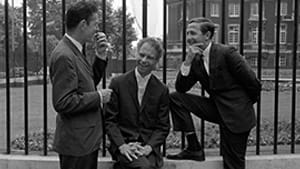Stay in the Loop
BSR publishes on a weekly schedule, with an email newsletter every Wednesday and Thursday morning. There’s no paywall, and subscribing is always free.
Dancing ahead of his time
Alla Kovgan’s ‘Cunningham’

Artistic innovators are often ahead of their time, which means they struggle for years while waiting for the public to catch up and reach an understanding of their vision. Think of Vincent van Gogh, whose genius wasn’t recognized until after his death. Dancer/choreographer Merce Cunningham, whose life receives a thoughtful treatment in Alla Kovgan’s new documentary, Cunningham, likewise worked for decades until his innovations were appreciated by the public.
Working out of a van
The film traces Cunningham’s artistic evolution from his early days as an impressive new dancer in the Martha Graham Company in the 1940s to his acceptance as a major force in modern dance in the 1970s.
Cunningham began his career in his hometown of Seattle in the 1930s. In 1939 he was invited by Martha Graham to move to New York and join her company. He presented his first solo concert in 1944, in collaboration with avant-garde composer John Cage, who became Cunningham’s lifelong romantic partner and collaborator.
Cunningham formed his own dance company in 1953, and he spent the next several years touring the country on the cheap. Audiences were sparse in those early days, and the company lived and worked out of the back of a van. During this period Cunningham continued to develop his innovative choreographic style, which often garnered a cool or puzzled reaction from audiences and critics.
Collaborative innovation
It was during this period that the artist also forged a number of fruitful collaborations. In addition to John Cage, another important early collaborator was artist Robert Rauschenberg, who served as the company’s resident designer from 1954 to 1964. Over the years, Cunningham would work with a virtual who’s who of important artistic innovators, including Jasper Johns, Roy Lichtenstein, and Andy Warhol. In his later years, Cunningham also teamed with innovative modern bands such as Radiohead, Sigur Ros, and Sonic Youth.
Unlike most biographical documentarians, Kovgan focuses less on lifetime facts than on an examination of Cunningham’s artistic evolution. Crucially, we learn that many of Cunningham’s early innovations were developed in collaboration with Cage. It was with Cage that Cunningham developed his belief that a dance and its music should not be intentionally coordinated with one another. The choreographer and composer would utilize random procedures to generate material, discarding many artistic traditions of narrative and form.
The work holds up
Kovgan draws on a large amount of archival performance footage to clarify exactly what Cunningham would do with his choreography. In addition, the director includes a number of modern, precise recreations of several of Cunningham’s more famous pieces, illustrating just how well his work has held up over the years.
While Merce Cunningham died in 2009 at the age of 90, the film focuses only on his career up to 1972, when he entered the period of his greatest acclaim. By then the public had finally caught up with Cunningham’s genius. Thanks to Kovgan’s thoughtful examination of the master’s work, we also get up to speed.
What, When, Where
Cunningham, directed by Alla Kovgan, opens on January 3 at the Ritz at the Bourse.
Sign up for our newsletter
All of the week's new articles, all in one place. Sign up for the free weekly BSR newsletters, and don't miss a conversation.

 Gary L. Day
Gary L. Day